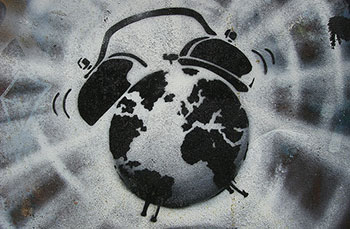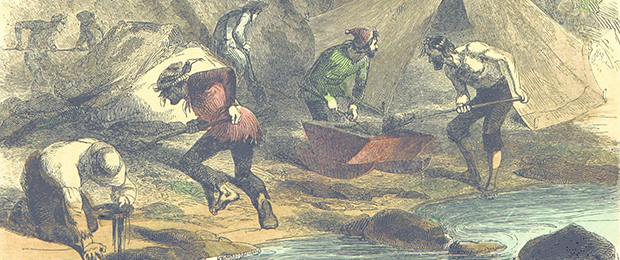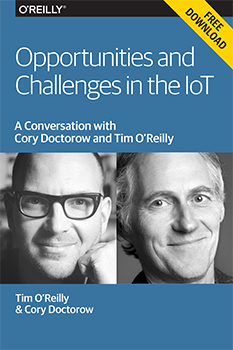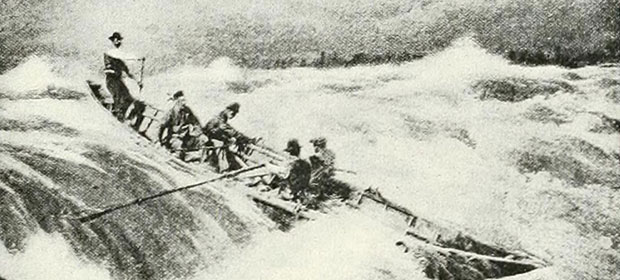Jenn Webb
Trillions of things sending billions of messages
The O'Reilly Radar Podcast: Mickey McManus on preparing for an era of unbounded malignant complexity.
Subscribe to the O’Reilly Radar Podcast to track the technologies and people that will shape our world in the years to come.
In this week’s episode of the Radar Podcast, O’Reilly’s Mike Hendrickson talks with Autodesk research fellow Mickey McManus about engaging with extreme users and what’s going to happen when we have trillions of things sending billions of messages. McManus also talked about how we can prepare for the coming era of unbounded malignant complexity.
Unbounded malignant complexity
In talking about Trillions, a book McManus co-authored with Peter Lucas and Joe Ballay, McManus explained what exactly we’re up against in the next five years as our world becomes more and more permeated with computation:
We are probably five years away from trillions of computing devices, and that wouldn’t be bad, but then imagine a world saturated with computers. It’s almost like a super-saturated solution. They’re not all connected, so maybe we could cope with that. But, concurrently, connectivity is joining Moore’s law — people like Intel are working on Moore’s law radio that basically puts all the parts of a radio on silicon. Which means that, suddenly, the cost of connectivity drops to dirt, to nothing, to dust.
We’ll have this super-saturated solution where that seed hits it, and we’re going to turn the sock inside out. We’re going to go from information in computers, like your super computer in your pocket, to us being surrounded by information. … The next information age will be an era of unbounded malignant complexity. Because there’s a lot of stuff. We have to get ready for that.
To create the future we want, we need more moonshots
The O'Reilly Radar Podcast: Tim O'Reilly and Astro Teller talk about technology and society, and the importance of moonshots.
Subscribe to the O’Reilly Radar Podcast to track the technologies and people that will shape our world in the years to come.
In this week’s Radar Podcast episode, Tim O’Reilly sits down with Google X’s Astro Teller. Their wide-ranging conversation covers moonshots, the relationship between technology and society, the learning process for hardware, and more. What follows are some snippets of their conversation to whet your appetite — you can listen to the entire interview in the SoundCloud player below, or download the podcast through Stitcher, TuneIn, or iTunes.
Technology doesn’t create net losses for the economy
Tim O’Reilly: The policy makers, I think, need to stop talking about creating jobs and start talking about the work we need to do in the world, because if you do that work, you do create jobs. I was struck by this when I went to Mount Vernon, George Washington’s home. He was really into scientific agriculture, as was Thomas Jefferson. He had this vision that America could feed the world. There was that economic vision: there is something that needs doing. One of the things I love about Google X is it’s driven by solving problems, and those problems actually often do create new opportunities for work.
Astro Teller: I completely agree with you about the problems. In addition, when you look at the history of technology — its introduction, and what happened in society afterword — technology has functioned in every case in the past as a lever for the human mind or for the human body. Things like the introduction of spreadsheets destroyed the business, the profession of bookkeeping — but because we trained people, we as society trained people, they became accountants, they became analysts. As many jobs as were lost were created, and more work, more productivity was created in the process. The bulldozer took away, in a very analogous way, a lot of jobs from people who were digging with shovels, but because we trained them to do things like build the bulldozers, drive the bulldozers, maintain the bulldozers, it wasn’t a net loss for the economy.
I believe that the failure mode we are currently in, to the extent that there’s a failure mode, is not the introduction of new technologies but the failure of our society to train the young people of the world so that they will be prepared to use these more and more sophisticated levers.
“Internet of Things” is a temporary term
The O'Reilly Radar Podcast: Pilgrim Beart on the scale, challenges, and opportunities of the IoT.
Subscribe to the O’Reilly Radar Podcast to track the technologies and people that will shape our world in the years to come.
In this week’s Radar Podcast, O’Reilly’s Mary Treseler chatted with Pilgrim Beart about co-founding his company, AlertMe, and about why the scale of the Internet of Things creates as many challenges as it does opportunities. He also talked about the “gnarly problems” emerging from consumer wants and behaviors.
The future of data at scale
The O'Reilly Radar Podcast: Turing Award winner Michael Stonebraker on the future of data science.
Subscribe to the O’Reilly Radar Podcast to track the technologies and people that will shape our world in the years to come.
In March 2015, database pioneer Michael Stonebraker was awarded the 2014 ACM Turing Award “for fundamental contributions to the concepts and practices underlying modern database systems.” In this week’s Radar Podcast, O’Reilly’s Mike Hendrickson sits down with Stonebraker to talk about winning the award, the future of data science, and the importance — and difficulty — of data curation.
One size does not fit all
Stonebraker notes that since about 2000, everyone has realized they need a database system, across markets and across industries. “Now, it’s everybody who’s got a big data problem,” he says. “The business data processing solution simply doesn’t fit all of these other marketplaces.” Stonebraker talks about the future of data science — and data scientists — and the tools and skill sets that are going to be required:
It’s all going to move to data science as soon as enough data scientists get trained by our universities to do this stuff. It’s fairly clear to me that you’re probably not going to retread a business analyst to be a data scientist because you’ve got to know statistics, you’ve got to know machine learning. You’ve got to know what regression means, what Naïve Bayes means, what k-Nearest Neighbors means. It’s all statistics.
All of that stuff turns out to be defined on arrays. It’s not defined on tables. The tools of future data scientists are going to be array-based tools. Those may live on top of relational database systems. They may live on top of an array database system, or perhaps something else. It’s completely open.
“The purpose of the IoT is to give humans superpowers”
Tim O’Reilly and Cory Doctorow talk about the opportunities and challenges presented by the Internet of Things.
Taking a look at industry, O’Reilly addressed a Twitter question from @leahthehunter regarding which companies and technologies are most profoundly impacting the evolution of the Internet of Things:
I think the biggest mistake people make with the Internet of Things is in thinking that it’s about devices. Sure, there are sexy devices: your Nest thermostat. Your Internet-connected drone, or whatever, and people go, ‘Oh, awesome.’ Yes, and there’s things like smart TVs, but the biggest impact to me seems to be when you start thinking about how sensors and devices can change the way you actually do things. … What really seems interesting is if you take Uber as a model of an Internet of Things company and use that as your icon rather than, say, Nest, you say, ‘Oh wait a minute — what’s really happening here is we’re saying once you have connectivity and sensors out in the world, you can actually completely rethink an industry.’
O’Reilly noted that the biggest opportunities in the IoT lie not in new devices but in rethinking user behavior to design better user experiences and increase value for users. Doctorow agreed, pointing out that he’s interested in the notion of “treating human beings as things that are good at sensing and not things that are there to be sensed.” Read more…
Guidance for startup CEOs in the hot seat
The O'Reilly Radar Podcast: Dan Shapiro on his new book Hot Seat, startup co-founders, and imposter syndrome.
Subscribe to the O’Reilly Radar Podcast to track the technologies and people that will shape our world in the years to come.
In this episode of the O’Reilly Radar Podcast, I chat with Dan Shapiro, author and CEO of Glowforge, about his new book Hot Seat: The Startup CEO Guidebook, why startups need co-founders, and why startups are hotbeds for imposter syndrome (and why that’s OK). He also talks a bit about his new endeavor, Glowforge, and how it’s different from other startups he’s launched.
Shapiro explained that the target audience for the book isn’t limited to startup CEOs — in fact, he noted, it’s quite the opposite. “The audience that I’m really excited about getting to see this is everybody who’s not the startup CEO,” he told me. This would include everyone else in the startup ecosystem: co-founders, employees working at a startup, and people employed at big companies who are thinking about taking the leap to found their own startups. He said he wrote this book for “people who are on the cusp or who are touching or who are thinking about that role, either directly or indirectly” — he wrote the book he’d wished he’d had when he started out:
The thing that I wished I’d had in my startup experience — and was always missing — was the honest and unfiltered look at the earliest days of a startup. That was not just, ‘here’s some advice,’ because advice is plentiful and mostly wrong, but real experiences of the stuff that happens. My personal experience, I’m on my fourth or fifth company now, depending on how you count, was that, especially in my first and second companies, I was going through misery and suffering and had these terrible problems. I thought I was the only one who did. I was ashamed to talk about them because everybody else seemed like everything was great and sunny, and I was like, ‘Wow, if my co-founders and I can’t get along, how am I even fit to think about running a company, or shouldn’t we just give up now.’
It was only years later that I realized that almost every set of co-founders has problems and has trouble getting along and runs into issues, and that’s okay. That there are techniques for dealing with that and this is actually really common; it’s just that people are ashamed to talk about it. I wanted to write the book that took lots of peoples’ stories and put them together in the context of, ‘look, startups involve a lot of highs, which there is no shortage of to read about in the press, but a lot of lows as well’ and those are not as often talked about; to talk about some of the experiences of those lows, and strategies for dealing with them.
The new fintech: mobile, decentralized, and friction-free
The O'Reilly Radar Podcast: Dele Atanda and Mutaz Qubbaj talk about their startup platforms and the disruption in fintech.
Learn more about Next:Money, O’Reilly’s conference focused on the fundamental transformation taking place in the finance industry.
In this Radar Podcast episode, I chat with Dele Atanda, founder and CEO of Digitteria, about the disruptive state of the financial tech industry, what he thinks is driving that disruption, and why smart data (as opposed to big data) is going to revolutionize finance. I also talk with Mutaz Qubbaj, CEO and co-founder of Squirrel, about about the Squirrel platform, accelerator programs, and how he views the big disruptors in fintech landscape.
We’ve started an investigation — and launched a new summit, Next:Money — here at O’Reilly to look into the disruption happening in the fintech industry, as burgeoning startups create services and products that threaten to disaggregate traditional finance incumbents. I recently had the opportunity to sit down with a number of fintech startup founders and will be featuring several of those conversations in upcoming Radar Podcasts.
Dele Atanda founded Digitteria, a startup developing sustainable identity and personal data management solutions for both consumers and enterprise. I asked him why the time is ripe for disruption — he pointed to the growing complexity of the landscape and compared the current state of the finance industry to the early stages of the Web:
There’s a significant increase in complexity, and in that complexity there’s a much more detailed and rich ecosystem. Banks, it’s difficult for them to be able to tackle all the ends and elements efficiently, so it’s interesting because it’s almost representative of, it’s lacking the evolution of the Web, but it mirrors it in very many ways. Initially, you had these monolithic sort of applications, or browsers, or services that tried to do lots of things, and then we moved into the mobile era where things became much more siloed and application centric, where you did one thing particularly well. That’s inevitably going to happen in the fintech space. They say that the currency of the industrial era was paper, and the currency of the knowledge era is the electron.
Money is primarily electronic now, so it’s inevitable that there’s going to become this confluence between the Web and finance in that regard. I think, of course, because of security, regulatory issues, and the cultural dimension of money, there’s been a lag and resistance. Now that the Web has reached a level of maturity that it can address those issues, I think that’s inevitable.
Signals from the 2015 O’Reilly Velocity Conference in Santa Clara
Key insights from DevOps, Web operations, and performance.
People from across the Web operations and performance worlds are coming together this week for the 2015 O’Reilly Velocity Conference in Santa Clara. Below, we’ve assembled notable keynotes, interviews, and insights from the event.
Think like a villain
Laura Bell outlines a three-step approach to securing organizations — by putting yourself in the bad guy’s shoes (without committing actual crime, she stresses):
- Think like a villain and be objective: identify why and how someone would attack your company; what is the core value they’d come to steal?
- Create a safe place to create a little chaos: don’t do it live, but find a safe place without restriction and without fear to break things, to practice creative chaos.
- Play like you’ve never read the the rule book: Not everyone plays by the same rules as you, so to protect yourself and your company, you have to think more like the person willing to break the rules.
Real-world interfaces are in an awkward and playful stage
The O'Reilly Radar Podcast: Josh Clark on the world as an interface, avoiding data rash, and the importance of play.
Subscribe to the O’Reilly Radar Podcast to track the technologies and people that will shape our world in the years to come.
 In this week’s episode of the Radar Podcast, O’Reilly’s Mary Treseler chats with Josh Clark, founder of design agency Big Medium (formerly known as Global Moxie). Clark talks about the changing nature of his work as the world itself becomes more of an interface, how to avoid “data rash,” and why in this time of rapid technology growth it’s essential for designers to splash in the puddles.
In this week’s episode of the Radar Podcast, O’Reilly’s Mary Treseler chats with Josh Clark, founder of design agency Big Medium (formerly known as Global Moxie). Clark talks about the changing nature of his work as the world itself becomes more of an interface, how to avoid “data rash,” and why in this time of rapid technology growth it’s essential for designers to splash in the puddles.
The world is the medium
The influence of the Internet of Things is beginning to touch every aspect of our lives, from how we communicate to how we work to how we play. This fundamental shift away from screens to the real-world around us not only is influencing how designers approach their craft, but is changing the medium itself in which designers work. Clark talked about this shift and how it’s affecting his own work:
Over the last couple of years, I’ve found the nature of my work has been changing as well as my interests. I think the culture of digital design is changing, too, as we start moving off of screens. It felt like an opportunity to redefine my own work, so I also did that with my agency and changed its name to Big Medium. The idea of that being that the Internet itself is a pretty big medium, and in fact starting to expand beyond the bounds that we’ve traditionally associated it with, which is the screen. Increasingly, as we’re seeing connected devices — the smart phones were kind of the leading edge of this, but now we’re starting to see wearables and the Internet of Things — this idea that the Internet is becoming embedded in our environment and in everyday objects means that anything can be an interface.
My work is starting to engage more and more with that truly big medium, which is the world itself. Finally, the world is the interface, which of course it always has been, but now we’re able to create digital experiences that belong to the world that we actually move in instead of us having to dive into the screens.
How Shazam predicts pop hits
The O'Reilly Radar Podcast: Cait O'Riordan on Shazam's predictive analytics, and Francine Bennett on using data for evil.
Subscribe to the O’Reilly Radar Podcast to track the technologies and people that will shape our world in the years to come.
 In this week’s Radar Podcast, I chat with Cait O’Riordan, VP of product, music and platforms at Shazam. She talks about the current state of predictive analytics and how Shazam is able to predict the success of a song, often in the first few hours after its release. We also talk about the Internet of Things and how products like the Apple Watch affect Shazam’s product life cycles as well as the behaviors of their users.
In this week’s Radar Podcast, I chat with Cait O’Riordan, VP of product, music and platforms at Shazam. She talks about the current state of predictive analytics and how Shazam is able to predict the success of a song, often in the first few hours after its release. We also talk about the Internet of Things and how products like the Apple Watch affect Shazam’s product life cycles as well as the behaviors of their users.
Predicting the next pop hit
Shazam has more than 100 million monthly active users, and its users Shazam more than 20 million times per day. This, of course, generates a ton of data that Shazam uses in myriad ways, not the least of which is to predict the success of a song. O’Riordan explained how they approach their user data and how they’re able to accurately predict pop hits (and misses):
What’s interesting from a data perspective is when someone takes their phone out of their pocket, unlocks it, finds the Shazam app, and hits the big blue button, they’re not just saying, “I want to know the name of this song.” They’re saying, “I like this song sufficiently to do that.” There’s an amount of effort there that implies some level of liking. That’s really interesting, because you combine that really interesting intention on the part of the user plus the massive data set, you can cut that in lots and lots of different ways. We use it for lots of different things.
At the most basic level, we’re looking at what songs are going to be popular. We can predict, with a relative amount of accuracy, what will hit the Top 100 Billboard Chart 33 days out, roughly. We can look at that in lots of different territories as well. We can also look and see, in the first few hours of a track, whether a big track is going to go on to be successful. We can look at which particular part of the track is encouraging people to Shazam and what makes a popular hit. We know that, for example, for a big pop hit, you’ve got about 10 seconds to convince somebody to find the Shazam app and press that button. There are lots of different ways that we can look at that data, going right into the details of a particular song, zooming out worldwide, or looking in different territories just due to that big worldwide and very engaged audience.







